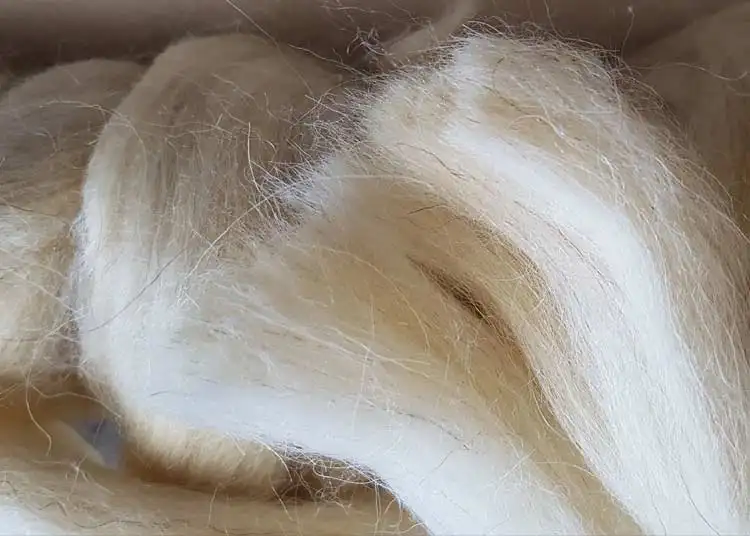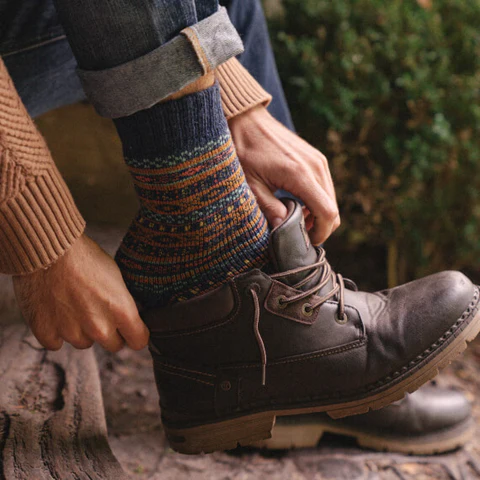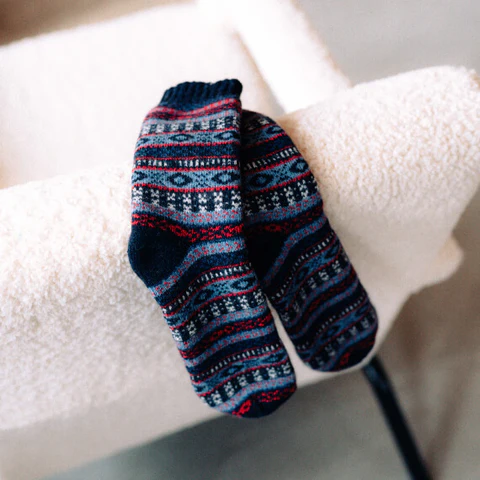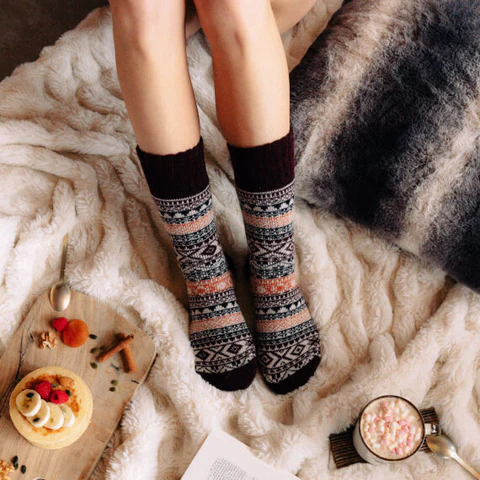According to a global fiber market survey, natural materials saw a 25% rise in consumer demand last year alone—proof that sustainability and superior performance drive sales. Enter wool socks, prized for their natural thermoregulation and impressive moisture-wicking abilities. These features help retailers reduce product returns while boosting brand loyalty. Beyond breathability, wool fibers resist odors and tolerate repeated wear without fraying, appealing to busy consumers seeking value for money. Businesses that invest in this reliable staple can differentiate themselves in a crowded market, offering an eco-friendly solution that meets growing customer expectations. By combining warmth, durability, and comfort, this evolving category delivers both immediate revenue potential and long-term brand credibility, making it a smart option for retailers aiming to stay competitive.

The Science of Wool Socks: Why They’re Superior
These specialized socks use natural fibers that provide warmth, manage sweat, and hold up well over time. Tiny air pockets help keep in heat without adding extra weight. The material also draws moisture away, so feet stay dry in warmer settings. It even fights odors, remaining fresh for longer than many synthetic options. Thanks to a soft texture—particularly in Merino varieties—they feel gentle on the skin and fit snugly without feeling tight. Whether for daily errands or challenging outdoor activities, they combine comfort and resilience in ways that standard choices often cannot match.
Thermal Insulation in Wool Socks
They contain built-in air spaces, which trap body heat and shield against low temperatures. This design offers cold-weather protection without the need for heavy layers, making these socks a smart option for winter commutes or chilly hikes.
Breathable & Sweat-Absorbent Construction
Their natural fibers pull moisture from the skin and release it into the air. This process helps prevent dampness and lowers the chance of bacteria buildup, keeping feet feeling clean and reducing the risk of blisters.
Antibacterial & Deodorizing Properties
Certain proteins within this yarn limit the growth of odor-causing microbes. Even with frequent use, they tend to stay fresher than many synthetic items, cutting down on extra laundry cycles.
Temperature Regulation for Any Climate
They adapt to both warm and cool settings, either letting heat escape or retaining it as needed. Wearers can rely on them across various seasons, whether working outdoors or relaxing at home.
Softness: Non-Itchy Fibers
Fine strands create a gentle surface that doesn’t rub or irritate the skin. Even after long periods of wear, they help prevent chafing, making them a good fit for people with sensitive feet.
Durability: Outlasting Typical Options
Quality craftsmanship and strong fibers lead to fewer holes or fraying. This level of toughness can mean fewer replacements over time, which may save both money and hassle in the long run.

Consumer Benefits: Why Wool Socks Are Worth the Investment
These natural-fiber garments bring reliability and versatility to anyone seeking comfortable, long-lasting footwear. Whether it’s transitioning between seasons or tackling an intense workout, they minimize the need for multiple sock types while offering excellent wear over time.
- All-Season Comfort: Wool Socks in Every Climate
By responding to changing temperatures, they help maintain a cozy yet breathable environment around the foot. Wearers don’t have to constantly switch socks when the weather shifts, saving both money and hassle.
- Odor Control: Why Wool Socks Stay Fresher
Their unique composition naturally hinders unpleasant smells. This characteristic keeps feet feeling cleaner throughout a busy day and cuts down on excessive washing, which adds to their long-term appeal.
- Health Perks: A Boost Beyond Basic Footwear
Gentle cushioning aids in reducing foot strain, especially for those who spend extended hours on the move. This kind of support can deliver incremental relief to tired arches and ankles, contributing to overall well-being.
- Eco-Conscious Choice: An Eye on Sustainability
Many versions of this product are produced using earth-friendly methods, reducing harm to the ecosystem. When consumers pick these durable alternatives, they help lessen waste and invest in a more responsible future.

Brand Opportunities: Meeting Modern Consumer Demands
Many buyers now expect both quality and ethical practices. Businesses can stand out by offering goods that match these desires, leading to better customer loyalty and stronger brand image.
- Rising Demand for Sustainable Fashion: Capitalize on Trends
Shoppers care about how products affect the environment. Showcasing items made with natural fibers highlights a commitment to reducing waste, appealing to those who value earth-friendly choices.
- Differentiate Your Line: Unique Selling Points of Wool Socks
Basic options often lose their appeal next to high-quality, long-lasting items. Emphasizing benefits like reliable odor control or sturdiness under regular use sets these products apart from cheaper, less durable alternatives.
- Targeting Markets: Hikers, Athletes, and Eco-Conscious Shoppers
Active people need gear that endures wear and tear. Outdoor enthusiasts look for comfort and the ability to avoid foot problems. Providing these qualities expands your reach among those who appreciate support and practical design.
- Pricing Strategy: Balancing Premium Quality and Affordability
Using top-grade fibers can raise production costs, yet transparent pricing helps buyers see long-term value. By offering multiple price tiers—entry-level, mid-range, and high-end—you welcome a broad spectrum of customers and encourage them to invest in products that deliver lasting benefits.

Wool Socks: Solving Real-World Problems
Everyday challenges like sudden cold snaps or unexpected rain can create discomfort. By using a natural fiber that helps trap warmth and manage moisture, these items tackle common issues in a straightforward way. They also stand up to regular use without wearing thin, making them a reliable choice for busy lives.
Cold Feet Fix: How Wool Socks Insulate in Harsh Conditions
Tiny air pockets in the fibers keep warmth close, offering protection against freezing weather. Despite providing solid insulation, these pieces remain light enough for easy movement.
Wet Winters, Dry Feet: Wool Socks That Resist Moisture
Absorbent fibers pull sweat away from skin, reducing the dampness that often leads to discomfort. This feature helps maintain dryness and can lower the risk of foot problems.
Friction-Free Wear: Prevent Blisters and Irritation
A soft texture, combined with a snug fit, decreases rubbing during daily routines or outdoor adventures. This design approach supports longer wear without the soreness caused by rough materials.
Less Laundry Time: Enjoy Fresher Use
Natural odor control lowers the need for constant washing, saving both water and effort. This aspect also contributes to overall product life, making them more cost-effective over time.
Odor Elimination: Banish Embarrassing Smells
Built-in properties fight microbes that produce unwanted scents. Active users especially appreciate this feature, as it keeps them feeling confident through busy days.
Wool Wock: Sustainability Spotlight
Eco-minded shoppers increasingly look for items that balance function with environmental care. By choosing products made from natural fibers, brands can address consumer concerns about waste and resource use. This step not only enhances credibility but also positions companies as forward-thinking leaders in the fashion world.
- Wool Wock’s Environmental Edge
Natural fibers return to the earth more easily, helping reduce pollution. Farming and processing techniques often have a smaller impact on land and water compared to synthetic materials, which depend on non-renewable inputs.
- Wool Wock and Responsible Farming
Transparent supply chains promote animal well-being and land preservation. When brands support ethical standards, they appeal to buyers who want their purchases to respect both people and wildlife.
- Marketing Eco-Friendly Credentials
Highlighting low-impact production methods helps attract those who appreciate green values. Simple steps like clear labeling and informative packaging can communicate a brand’s vision in a way that resonates with modern audiences.
- Recycling and Repurposing for a Circular Future
When items reach the end of their lifecycle, recovering and converting them into new goods keeps materials in use longer. Encouraging these practices can form part of a broader sustainability strategy, helping businesses stand apart in a competitive market.
Debunking Myths: Separating Fact from Fiction About Wool
- “Wool Is Scratchy”: Debunking Comfort Misconceptions
Many assume that garments made from this natural fiber are always rough against the skin. However, advancements in textile production have led to incredibly soft variations, such as merino. These modern options are designed for comfort, offering a smooth texture that feels pleasant throughout the day.
- “High Maintenance”: The Truth About Caring for Wool Socks
A common belief is that these fibers demand excessive care. In reality, they resist odors and require fewer washes compared to other materials. Many blends are machine washable, maintaining their integrity with minimal effort. Simply using cold water and gentle detergent ensures long-lasting durability.
- “Too Expensive”: Calculating Long-Term Value for Customers
While initial costs might seem higher, the longevity of these textiles makes them a smart investment. Their resilience against wear and ability to retain shape means fewer replacements over time. When factoring in durability and performance, the cost per use proves to be highly economical.
- “Only for Winter”: Showcasing Year-Round Versatility
This fabric naturally regulates temperature, keeping wearers warm in cold conditions and cool when temperatures rise. Its moisture-wicking ability ensures breathability, making it ideal for various climates. Whether for summer hikes or chilly evenings, it provides reliable comfort in every season.
Conclusion
Wool work socks solve common problems like cold feet, sweat, and odor, while lasting longer than ordinary socks. By partnering with our factory, you gain access to customizable, science-backed designs that elevate your brand, reduce returns, and build loyalty. Contact us! We’re here to provide a custom wool sock solution that sets you apart in a crowded market.
FAQs
How do I care for wool socks to maximize lifespan?
Wash them on a gentle or cold cycle, and avoid harsh detergents. Air drying helps keep their shape, though low-heat tumble drying can work if the care label allows. Read this article The Ultimate Guide: How to Wash Wool Socks to learn more.
Do wool socks work for diabetic or sensitive skin?
Yes. Their gentle fibers and moisture control can help reduce friction-related problems, which is important for those with tender feet. Many wearers report fewer irritations, though it’s always best to seek professional advice when dealing with serious conditions.
Are wool socks suitable for athletes or high-intensity activities?
Yes. Their breathable fibers handle sweat and reduce foot irritation, making them ideal for running, cycling, and other active sports. They also offer light cushioning to ease impact on joints.
Can wool socks be blended with other materials for better performance?
Absolutely. Many manufacturers mix in nylon or spandex for added stretch and durability, while still keeping the natural benefits that come from this classic fiber.
What certifications should brands look for in ethical wool sourcing?
Programs like the Responsible Wool Standard (RWS) or ZQ Merino confirm responsible farming and high welfare practices. These certifications show care for both animals and the environment, helping brands meet eco-friendly goals.
